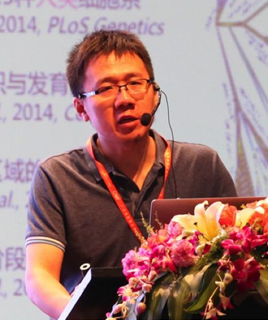赵方庆
时间:2020-08-14 18:22来源:未知 作者:admin 点击: 次

个人简介:
博士,研究员、中国科学院大学医学院岗位教授、优青基金获得者、首届北京市杰青基金获得者。2006年在中国科学院海洋研究所获博士学位,研究方向为海洋微藻的进化基因组学,在此期间获"中国科学院院长特别奖"和"国家海洋科学技术奖一等奖"。2006年7月至2010年12月在美国宾州州立大学比较基因组学和生物信息学研究中心,从事计算生物学和基因组学研究工作。2011年被中国科学院北京生命科学研究院聘为研究员。现任中科院北京生科院科研部副主任、中科院北京生命科学大型仪器区域中心办公室主任、计算生物学联合研究中心秘书长、中国生物工程学会计算生物学专业委员会副主任。在Briefings in Bioinformatics、Genomics、Proteomics & Bioinformatics、BMC Evolutionary Biology、Medicine in Microecolgy和Hereditas等国际学术刊物担任副主编或编委。近年来 ,先后主持国家自然科学基金7项(青年、面上、培育、重点和国家重点研发计划课题3项、国防科技创新特区项目、中国科学院"科技创新交叉与合作团队"项目和中科院院长特别奖基金等。近年来,围绕着"计算基因组学"研究方向,建立了一系列原创性的生物信息学算法和工具,并在环形非编码RNA和微生物组领域取得重要进展。在Gut、Genome Biology、Nature Communications、ISME J、Current Biology和Nucleic Acids Res 等刊物上发表通讯作者论文40余篇,平均影响因子超过11;研究论文总引用次数超过5500次(H-index 37),其中多篇入选ESI高被引论文;参与编写中英文专著4部;连续3年荣获"中国科学院优秀导师奖"(2017,2018,2019);培养的研究生已有5人次获得"中科院院长奖"和"中科院优秀博士学位论文"。
研究领域:
1.基因组变异与精准医学
遗传变异不仅是人类表型变化的基础,也是疾病易感性的基础。近年来,以基因组测序为核心技术的精准医学研究成为大家关注的热点,基因突变信息的识别是精准医学的核心关键技术。然而,目前对海量基因组数据中遗传变异,尤其是结构变异的挖掘算法远未成熟。我们重点关注基因组结构变异挖掘中的关键性问题(如结构变异中断点的精准定位、重复序列区域附近的结构变异识别等),提出新的计算方法,建立较为完善的统计学模型及质量评估标准,以便快速、准确的从海量数据中挖掘出基因组结构变异。随着高通量测序技术的进步以及越来越多的个人基因组数据的出现,深度挖掘和分析其中的遗传变异,将对我们深入理解复杂性状疾病的分子机制、鉴定易感基因和认识遗传变异和疾病表型的关系具有重要意义。
2.环形非编码RNA
近年来,环形RNA(circular RNAs)成为非编码RNA领域一个新的研究热点。与现有的线性非编码RNA分子不同,环形RNA是一类由线性RNA通过3',5'-磷酸二酯键将两端相连而形成的RNA环状分子。然而由于计算方法及研究手段的限制,目前只发现少部分环形RNA并且绝大多数无法了解其功能。尤其是目前对更多环形RNA功能的探知和验证仍需要更多新颖的理论假说和大量的实验验证。但在此之前,能否从海量的RNA测序数据中高效识别环形RNA及其不同形式的转录本,成为后续功能验证及表达调控机制研究的重要前提。针对环形RNA的计算方法学问题,我们建立了环形RNA识别和质控、转录本组装、可变剪接识别及定量等一系列方法和工具。这些研究丰富了我们对环形RNA的组成及结构的认识,为深入解析这一崭新类型的非编码RNA分子提供了重要工具。
3.宏基因组技术与人体健康
微生物广泛存在于各种生态环境中,与我们的生产、生活及自身健康密切相关。基于高通量测序的宏基因组学技术,已成为研究微生物群落组成、结构及功能最主要的技术手段。然而受高通量测序技术的限制,宏基因组研究中所利用的实验技术和计算方法遇到了很多困难。我们针对宏基因组研究的关键问题,重点开发基于单细胞测序技术的宏基因组拼接、序列归类和注释等方面的算法和工具。利用功能基因组学和代谢组学技术,研究人体口腔和肠道微生物组,揭示不同病理条件下微生物群落结构的组成、代谢功能及其变化规律。整合基因组学、计算生物学和系统生物学的研究手段,了解人类健康、生物被膜形成机制以及宿主与致病菌的相互作用等科学问题。
代表论著:
Zhang J, Chen S, Yang J & Zhao F*. Accurate quantification of circular RNAs identifies extensive circular isoform switching events. Nature Communications, 2020, 11:90.
Zheng Y & Zhao F*. Visualization of circular RNAs and their internal splicing events from transcriptomic data. Bioinformatics, 2020, btaa033
Ji P, Wu W, Chen S, et al, Zhao F*. Expanded expression landscape and prioritization of circular RNAs in mammals. Cell Reports, 2019, 26:3444-3460.
Wang J, Jia Z, Zhang B, Peng L & Zhao F*. Tracing the accumulation of in vivo human oral microbiota elucidates microbial community dynamics at the gateway to the gastrointestinal tract. Gut, 2019 10.1136/gutjnl-2019-318977.
Zheng Y, Ji P, Chen S, Hou L & Zhao F*. Reconstruction of full-length circular RNAs enables isoform-level quantification. Genome Medicine, 2019, 11:2.
He M, Wang J, Fan X, Liu X, Shi W, Huang N, Zhao F* & Miao M*. Genetic basis for the establishment of endosymbiosis in Paramecium. ISME J. 2019, 13(5): 1360-1369.
Wang J, Zheng J, Shi W, Du N, Xu X, Zhang Y, Ji P, Zhang F, Jia Z, Wang Y, Zheng Z, Zhang H & Zhao F*. Dysbiosis of maternal and neonatal microbiota associated with gestational diabetes mellitus. Gut, 2018, 67:1614-1625.
Gao Y & Zhao F*. Computational strategies for exploring circular RNAs. Trends in Genetics, 2018, 34(5): 389-400.
Zhou L & Zhao F*. Prioritization and functional assessment of noncoding variants associated with complex diseases. Genome Medicine 2018, 10:53.
Teng H, Zhang Y, Shi C, Mao F, Cai W, Lu L, Zhao F*, Sun Z* & Zhang J*. Population genomics reveals speciation and introgression between Brown Norway rats and their sibling species. Molecular Biology Evolution 2017, 34(9):2214-2228.
Ji P, Zhang Y, Wang J & Zhao F*. MetaSort untangles metagneome assembly by reducing microbial community complexity. Nature Communications, 2017, 8:14306.
Shi W, Ji P & Zhao F*. The combination of direct and paired link graphs boosts repetitive genome assembly. Nucleic Acids Res 2017, 45 (6): e43.
Gao Y, Zhang J & Zhao F*. Circular RNA identification based on multiple seed matching. Briefings in Bioinformatics 2018, 19(5):803-810.
Peng G, Ji P & Zhao F*. A novel codon-based de Bruijn graph algorithm for gene construction from unassembled transcriptomes. Genome Biology 2016, 17:232.
Gao Y, Wang J, Zheng Y, Zhang J, Chen S & Zhao F*. Comprehensive identification of internal structure and alternative splicing events in circular RNAs. Nature Communications 2016, 7:12060.
Zhang Y, Ji P, Wang J & Zhao F*. RiboFR-Seq: a novel approach to linking 16S rRNA amplicon profiles to metagenomes. Nucleic Acids Res. 2016, 44:e99.
Zhang Z, Xu D, Wang L, Hao J, Wang J, Zhou X, Wang W, Qiu Q, Huang X, Zhou J, Long R*, Zhao F* & Shi P*. Convergent evolution of rumen microbiomes in high-altitude mammals. Current Biology, 2016, 26(14): 1873-1879.
Wang J, Gao Y & Zhao F*. Phage-bacteria interaction network in human oral microbiome. Environmental Microbiology. 2016, 18(7):2143-2158.
Gao Y, Wang J & Zhao F*. CIRI: an efficient and unbiased algorithm for de novo circular RNA identification. Genome Biology. 2015, 16:4.
Zhao H & Zhao F*. BreakSeek: a breakpoint-based algorithm for full spectral range INDEL detection. Nucleic Acids Res. 2015, 43 (14):6701-6703.
Ye N^*, Zhang X^, Miao M^, Fan X^, Zheng Y, Xu D, Wang J, Zhou L, Wang D, Gao Y, Wang Y, Shi W, Ji P, Li D, Guan Z, Shao C, Zhuang Z, Gao Z, Qi J* & Zhao F*. Saccharina genomes provide novel insight into kelp biology. Nature Communications. 2015, 6: 6986.
